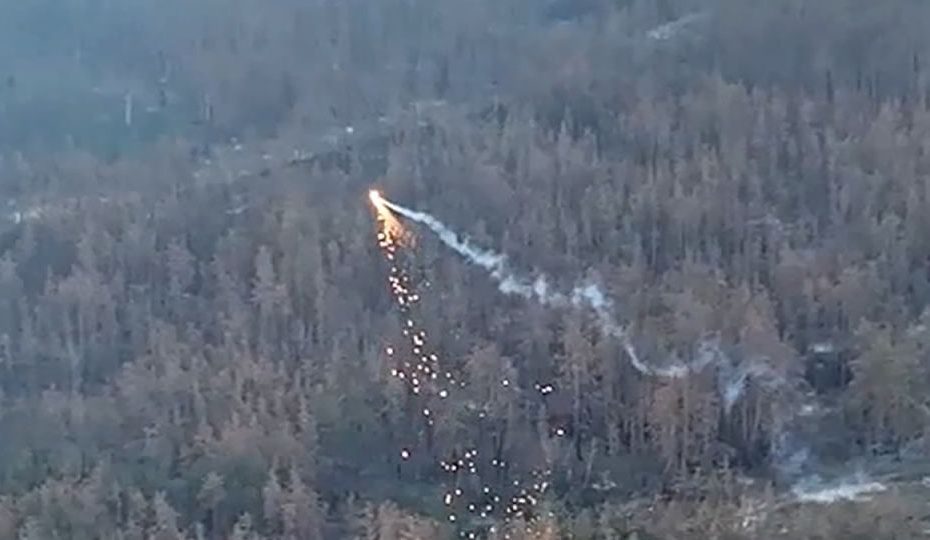Ukraine is reportedly deploying a fleet of fire-breathing “dragon drones” in its war against Russian invaders, putting a modern twist on a type of munitions used to horrific effect in both world wars.
A series of videos posted on social media on Wednesday, including Ukraine's Defense Ministry's Telegram, showed low-flying drones firing streams of fire — essentially molten metal — at Russian-held positions in the treelines.
The red-hot mixture of aluminum powder and iron oxide, called thermite, burns at temperatures of up to 4,000 degrees Fahrenheit (2,200 degrees Celsius). It can quickly burn trees and vegetation providing cover for Russian troops, or even kill or disable them.
When the thermite falls from the drone, it resembles the fire coming from the mouth of the mythical dragon, giving the drones their nickname.
“Strike Drones are our wings of revenge, bringing fire straight from the sky!” read a social media post from the 60th Mechanized Brigade of Ukraine.
“They pose a real threat to the enemy, burning down his positions with an accuracy that no other weapon can match,” the message continues.
“If our 'Vidar' works, the Russian woman will never sleep,” it added. Vidar is the Norse god of vengeance.
Creating this kind of fear is likely the most important effect of Ukraine's thermite drones, according to Nicholas Drummond, a defense industry analyst specializing in land warfare and a former British Army officer.
“It's very nasty stuff. It's quite innovative to deliver it by drone. But used that way, the effect will be more psychological than physical,” Drummond told CNN.
“I understand that Ukraine has only a limited capability to deliver a thermite effect, so this is a niche capability rather than a new mainstream weapon,” he said.
But he acknowledges the fear thermite can cause.
“I wouldn't have liked to be the recipient,” Drummond said.
Incendiary weapons in war
Thermite can easily burn through almost anything, including metal. So there is little protection against thermite.
It was discovered in the 1890s by a German chemist and was originally used to weld railroad tracks.
But its military power soon became apparent when the Germans dropped it as bombs on Britain from zeppelins during World War I, according to a history from McGill University in Montreal.
Both Germany and the Allies used thermite air bombs in World War II. They also used it to disable captured artillery pieces. They put thermite in the chamber and melted the weapon shut from the inside.
According to Action on Armed Violence (AOAV), a British anti-war organization, Ukraine has previously used thermite dropped from drones to permanently disable Russian tanks.
The thermite is “dropped directly through the hatches, where the intense heat quickly ignites and destroys everything inside,” an AOAV report said.
“This precision, combined with the drone's ability to evade traditional defenses, makes thermite bombs an extremely effective tool in modern warfare,” the report said.
Thermite is just one type of incendiary weapon; there are other types, such as napalm and white phosphorus.
According to the United Nations Office for Disarmament Affairs, incendiary weapons can cause enormous destruction and damage to the environment.
“The fires caused by or ignited by the weapon itself are difficult to predict and contain. For this reason, incendiary weapons are often described as 'area weapons' because of their impact over a large area,” the website reads.
The United States used napalm to burn down much of Japan's capital city during the infamous bombardments of Tokyo in World War II. U.S. forces also used it extensively in Vietnam.
The U.S. military has also used thermite in grenades. The U.S. military produced the weapons at the Pine Bluff Arsenal from the 1960s through 2014. Production resumed in 2023.
What thermite does to people
Under international law, thermite is not prohibited for military purposes, but its use on civilian targets is prohibited because of the terrible effects it can have on the human body.
In a 2022 report on incendiary weapons such as thermite, Human Rights Watch called them “notorious for their horrific human costs,” including inflicting fourth- and fifth-degree burns.
“They can damage muscles, ligaments, tendons, nerves, blood vessels and even bones,” HRW said.
Treatment can take months and requires daily attention, and survivors are left with physical and psychological scars, HRW said.
Russian President Vladimir Putin ordered a full-scale invasion of Ukraine in February 2022. Moscow's initial advance into Ukraine was stopped, but the capture of the capital, Kiev, was not completed. The sides fought over the same territory for most of the war.
Outnumbered and outgunned by Russia, Ukraine's armed forces have been adept at innovating with small drones to target Moscow's troops and equipment.
A Ukrainian invasion of Russian territory near Kursk in August caught Putin by surprise and boosted Ukraine's confidence that it can win the war.
Kiev accuses Russian forces of using unspecified incendiary munitions against civilian targets earlier in the war, including in May 2022 on a village outside Kharkiv, Ukraine's second-largest city.
CNN's Nick Paton Walsh visited that village, Cherkaski Tyshky, shortly after a Russian attack and described a scene of “houses, fields, even the sky itself, set on fire.”
Ukrainian officials also accused Russia of using firebombs in attacks on the city of Bakhmut last year.
The use of firebombs has not given Russia a quick victory, nor does Drummond believe it will radically change the situation for Ukraine.
“If Ukraine really wants to make an impact, it needs enough mass to force a good breakthrough like it did in Kursk. That's what victory looks like,” Drummond said.
But thermite gives Russian forces another reason to fear Ukrainian drones, he said.
“We have seen examples of Russian forces being attacked by multiple drones and abandoning their positions. The more Ukraine can instill fear of drones, the greater the chance of success,” he said.
“Thermite keeps the pressure high.”
For more CNN news and newsletters, create an account at CNN.com

